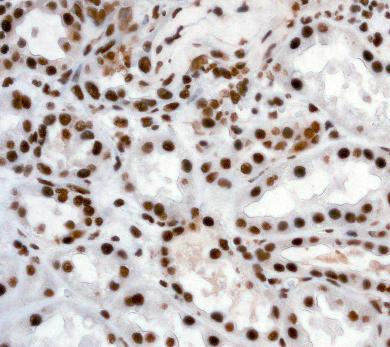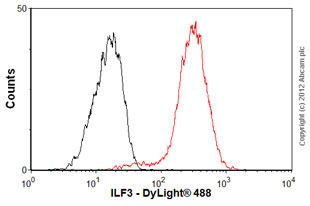![ILF3 was immunoprecipitated using 0.5mg K562 whole cell extract, 5µg of Rabbit monoclonal to ILF3 and 50µl of protein G magnetic beads (+). No antibody was added to the control (-).The antibody was incubated under agitation with Protein G beads for 10min, K562 whole cell extract lysate diluted in RIPA buffer was added to each sample and incubated for a further 10min under agitation.Proteins were eluted by addition of 40µl SDS loading buffer and incubated for 10min at 70°C; 10µl of each sample was separated on a SDS PAGE gel, transferred to a nitrocellulose membrane, blocked with 5% BSA and probed with ab92355.Secondary: Mouse monoclonal [SB62a] Secondary Antibody to Rabbit IgG light chain (HRP) (ab99697).Band: 95kDa; ILF3](http://www.bioprodhub.com/system/product_images/ab_products/2/sub_3/8226_ab92355-168544-IPV017ab9235516min.jpg)
ILF3 was immunoprecipitated using 0.5mg K562 whole cell extract, 5µg of Rabbit monoclonal to ILF3 and 50µl of protein G magnetic beads (+). No antibody was added to the control (-).The antibody was incubated under agitation with Protein G beads for 10min, K562 whole cell extract lysate diluted in RIPA buffer was added to each sample and incubated for a further 10min under agitation.Proteins were eluted by addition of 40µl SDS loading buffer and incubated for 10min at 70°C; 10µl of each sample was separated on a SDS PAGE gel, transferred to a nitrocellulose membrane, blocked with 5% BSA and probed with ab92355.Secondary: Mouse monoclonal [SB62a] Secondary Antibody to Rabbit IgG light chain (HRP) (ab99697).Band: 95kDa; ILF3
![All lanes : Anti-ILF3 antibody [EPR3626] (ab92355) at 1/100000 dilutionLane 1 : Raji cell lysateLane 2 : HeLa cell lysateLane 3 : K562 cell lysateLysates/proteins at 10 µg per lane.SecondaryHRP labelled goat anti-rabbit antibody at 1/2000 dilution](http://www.bioprodhub.com/system/product_images/ab_products/2/sub_3/8227_ILF3-Primary-antibodies-ab92355-1.jpg)
All lanes : Anti-ILF3 antibody [EPR3626] (ab92355) at 1/100000 dilutionLane 1 : Raji cell lysateLane 2 : HeLa cell lysateLane 3 : K562 cell lysateLysates/proteins at 10 µg per lane.SecondaryHRP labelled goat anti-rabbit antibody at 1/2000 dilution

ab92355 at 1/100 dilution staining ILF3 in paraffin-embedded Human kidney tissue, by immunohistochemistry.

Overlay histogram showing HeLa cells stained with ab92355 (red line). The cells were fixed with 80% methanol (5 min) and then permeabilized with 0.1% PBS-Tween for 20 min. The cells were then incubated in 1x PBS / 10% normal goat serum / 0.3M glycine to block non-specific protein-protein interactions followed by the antibody (ab92355, 1/100 dilution) for 30 min at 22ºC. The secondary antibody used was DyLight® 488 goat anti-rabbit IgG (H+L) (ab96899) at 1/500 dilution for 30 min at 22ºC. Isotype control antibody (black line) was rabbit IgG (monclonal) (1µg/1x106 cells) used under the same conditions. Acquisition of >5,000 events was performed.
![ILF3 was immunoprecipitated using 0.5mg K562 whole cell extract, 5µg of Rabbit monoclonal to ILF3 and 50µl of protein G magnetic beads (+). No antibody was added to the control (-).The antibody was incubated under agitation with Protein G beads for 10min, K562 whole cell extract lysate diluted in RIPA buffer was added to each sample and incubated for a further 10min under agitation.Proteins were eluted by addition of 40µl SDS loading buffer and incubated for 10min at 70°C; 10µl of each sample was separated on a SDS PAGE gel, transferred to a nitrocellulose membrane, blocked with 5% BSA and probed with ab92355.Secondary: Mouse monoclonal [SB62a] Secondary Antibody to Rabbit IgG light chain (HRP) (ab99697).Band: 95kDa; ILF3](http://www.bioprodhub.com/system/product_images/ab_products/2/sub_3/8226_ab92355-168544-IPV017ab9235516min.jpg)
![All lanes : Anti-ILF3 antibody [EPR3626] (ab92355) at 1/100000 dilutionLane 1 : Raji cell lysateLane 2 : HeLa cell lysateLane 3 : K562 cell lysateLysates/proteins at 10 µg per lane.SecondaryHRP labelled goat anti-rabbit antibody at 1/2000 dilution](http://www.bioprodhub.com/system/product_images/ab_products/2/sub_3/8227_ILF3-Primary-antibodies-ab92355-1.jpg)

